Unit 6 At one with nature Starting out & Understanding ideas 课件(共29张)
文档属性
| 名称 | Unit 6 At one with nature Starting out & Understanding ideas 课件(共29张) |  | |
| 格式 | pptx | ||
| 文件大小 | 54.8MB | ||
| 资源类型 | 教案 | ||
| 版本资源 | 外研版(2019) | ||
| 科目 | 英语 | ||
| 更新时间 | 2024-10-20 11:51:49 | ||
图片预览

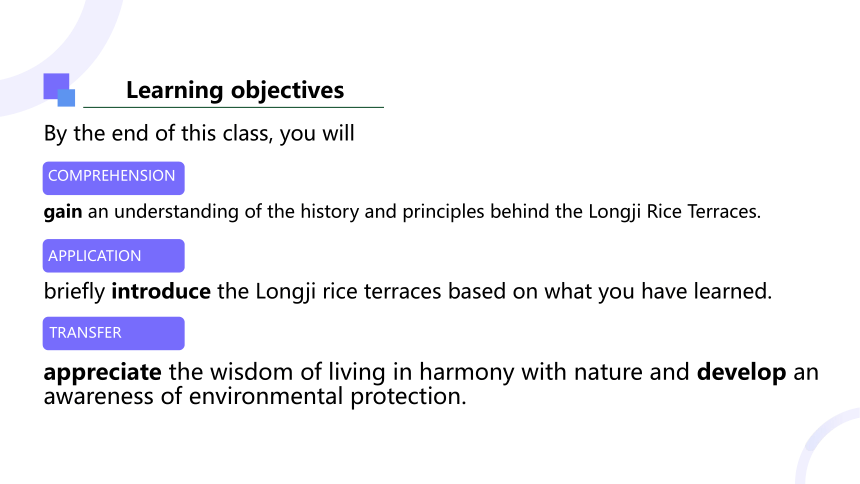

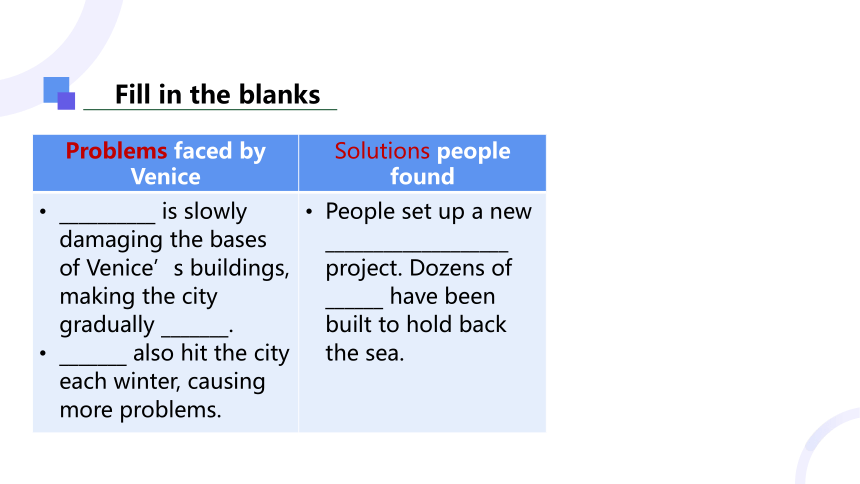
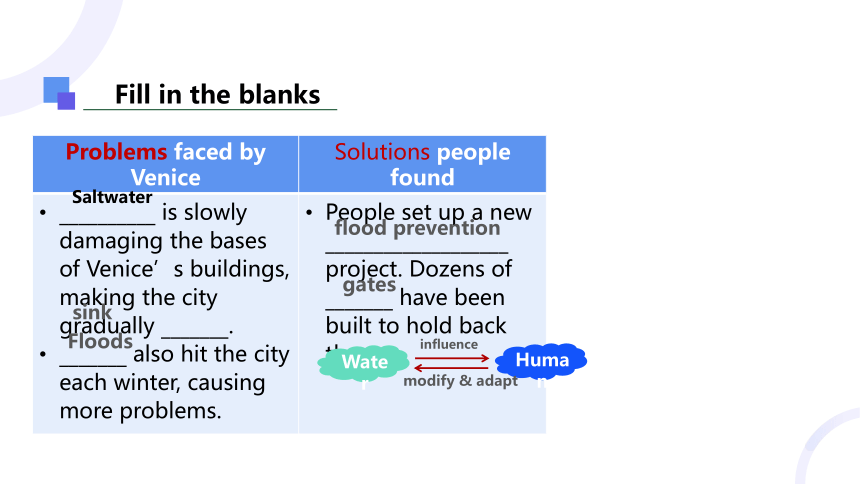

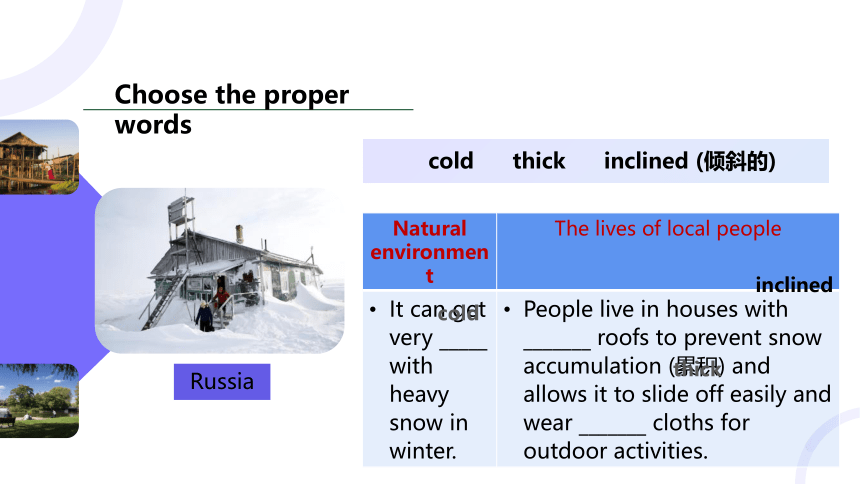
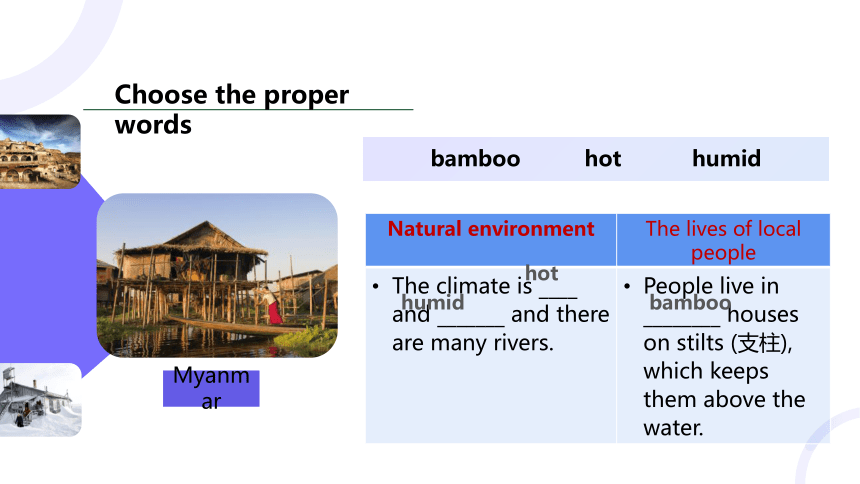
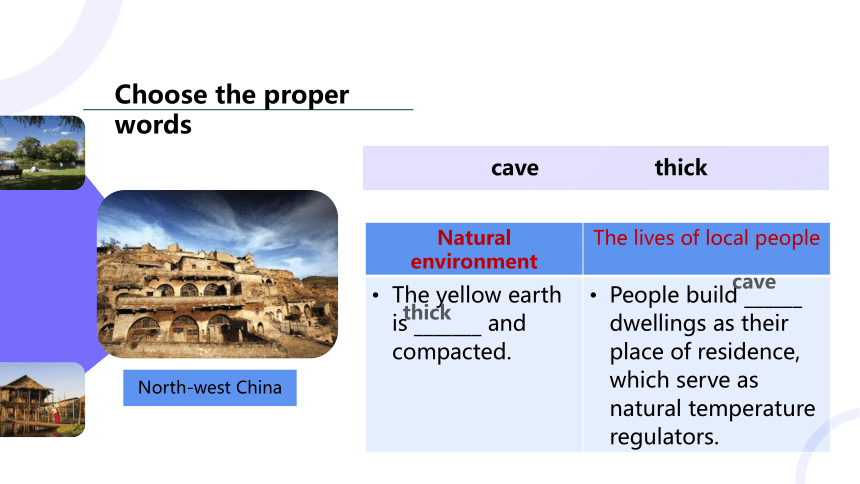
文档简介
(共29张PPT)
Unit 6 At one with nature Starting out & Understanding ideas
Learning objectives
By the end of this class, you will
COMPREHENSION
APPLICATION
TRANSFER
gain an understanding of the history and principles behind the Longji Rice Terraces.
briefly introduce the Longji rice terraces based on what you have learned.
appreciate the wisdom of living in harmony with nature and develop an awareness of environmental protection.
1 Lead in
Problems faced by Venice Solutions people found
__________ is slowly damaging the bases of Venice’s buildings, making the city gradually _______. _______ also hit the city each winter, causing more problems. People set up a new ___________________ project. Dozens of ______ have been built to hold back the sea.
Fill in the blanks
Problems faced by Venice Solutions people found
__________ is slowly damaging the bases of Venice’s buildings, making the city gradually _______. _______ also hit the city each winter, causing more problems. People set up a new ___________________ project. Dozens of _______ have been built to hold back the sea.
Saltwater
sink
Floods
flood prevention
gates
Fill in the blanks
Human
Water
influence
modify & adapt
Natural environment The lives of local people
It can get very _____ with heavy snow in winter. People live in houses with _______ roofs to prevent snow accumulation (累积) and allows it to slide off easily and wear _______ cloths for outdoor activities.
cold thick inclined (倾斜的)
Choose the proper words
cold
inclined
thick
Russia
Natural environment The lives of local people
The climate is ____ and _______ and there are many rivers. People live in ________ houses on stilts (支柱), which keeps them above the water.
Choose the proper words
bamboo hot humid
Myanmar
humid
bamboo
hot
Choose the proper words
Natural environment The lives of local people
The yellow earth is _______ and compacted. People build ______ dwellings as their place of residence, which serve as natural temperature regulators.
North-west China
cave thick
thick
cave
Choose the proper words
Natural environment The lives of local people
The ______ climate and parks in towns provide a pleasant natural environment. People _______ and enjoy life.
United Kingdom
mild relax
mild
relax
Climate
Water
Soil
cold
hot
humid
Human
influence
modify & adapt
Natural
environments
...
Longji Rice Terraces
Beauty
What do you want to know about it
Where is it
Who built it
Why did they build it
How long did they build it
2 Expectation
Colors
(beauty)
History
Reasons
Working principle
Values
(significance)
Tip 1: Pay attention to the first and the last sentences of each paragragh.
3 Read for main ideas
Exposition.
Narration.
Argumentation.
What is the genre (体裁) of the passage
3 Read for main ideas
Colors
(beauty)
Values
(significance)
Working principle
Reasons
History
Introduction
Main body
Conclusion
What’s the author’s purpose in writing the passage
1. To praise the wisdom of the ethnic groups living in Guangxi Zhuang Autonomous Region.
2. To explain how people worked in harmony with nature to create the Longji Rice Terraces.
3. To describe the beauty of the Longji Rice Terraces and to attract visitors to this scenic spot.
3 Read for main ideas
Tip 2: Exposition serves to explain, describe, or inform the audience about a particular subject or topic.
Para. 1: Colors (beauty)
What’s the function of para.1
To capture reader’s attention
To introduce the topic
Tip 3: Writing skill——use hooks
4 Read for detailed information
Imagery: 1). Evoke visual sensations. 2). Enhance the reader’s ability to imagine the described scenes.
Para. 1: Colors (beauty)
Mountains are wrapped in silver water, shining in the spring sun.
Summer sees the mountains turn bright green with growing rice.
During autumn, these same mountains are gold.
In winter, they are covered in sheets of white frost.
Find somes words to describe the beauty of each season.
Mountains are wrapped in silver water, shining in the spring sun.
Summer sees the mountains turn bright green with growing rice.
During autumn, these same mountains are gold.
In winter, they are covered in sheets of white frost.
Parallel structure: Adds a sense of rhythm and harmony in the writing.
Mountains are wrapped in silver water, shining in the spring sun.
Summer sees the mountains turn bright green with growing rice.
During autumn, these same mountains are gold.
In winter, they are covered in sheets of white frost.
山峦银波映春光,
夏至绿浪浸稻田。
秋临金黄山色变,
冬至白雪覆峰巅。
Para. 1: Colors (beauty)
Mountains are wrapped in silver water, shining in the spring sun.
Summer sees the mountains turn bright green with growing rice.
During autumn, these same mountains are gold.
In winter, they are covered in sheets of white frost.
The beauty of scenery
Who
When
Para. 3: Reasons
entire mountains
terraces
few large, flat areas of land
steep mountains, shallow soil
catch the rainwater,
hold the soil
increase areas to grow rice
problem
solution
Economic benefits
Ecological benefits
The beauty of Chinese wisdom
How
Para. 4: Working principle
waterways
rain
clouds
heat
vapor
②
③
④
move down...into...along...
form
Water cycle
Rainwater moves down the mountains and into the terraces along the waterways.
The sun heats the water and turns it into vapor.
Vapor forms clouds from which rain falls down onto the terraces.
fall down
turn
Some logical words:
During… First...Then... Next...After that...At last...
Para. 4: Working principle
... falls down onto the mountain terraces once again. These terraces also provide a perfect environment for birds and fish, some of which feed on insects that can harm the rice crops.
... falls down onto the mountain terraces once again. These terraces also provide a perfect environment for birds and fish, some of which feed on insects that can harm the rice crops.
provide the environment
feed on
harm
protect
The beauty of sustainable development
Para. 5: Values (significance)
Agriculture:
Food producers
What are the functions of Longji Rice Terraces
Culture:
Tourism:
Tradition bearers
Tourist attraction
Why do the local people still keep their traditional way of growing rice
To protect the environment.
To pass down the tradition.
To support the tourism.
The beauty of Chinese culture
Agricultural culture
农耕文化
Folk culture 民俗文化
Ethnic culture 民族文化
5 Summary
Longji Rice Terraces change colors with the seasons: silver in spring, blue in summer, golden in autumn, and frosty white in winter. They were built by the local Zhuang and Miao ethnic groups for hundreds of years. Since there are many large, flat areas in the region, they built terraces on the mountains to have more areas to grow rice. The terraces are cleverly designed, and can wash away the shallow soil. There are hundreds of waterways, along which rainwater moves down the mountains and into the terraces. Today, local people use modern methods to maintain the terraces, and they attract lots of visitors from all over the country.
Read the summary of the passage and correct five factual mistakes.
green
Yao
few
hold
ancient
The beauty of Chinese spirit
The beauty of Chinese wisdom
The beauty of Chinese culture
Beauty
The beauty of sustainable development
Colors
(beauty)
Values
(significance)
Working principle
Reasons
History
The beauty of scenery
6 Group work
Recommend Longji Rice Terraces to your friends for vacation.
Colors
(beauty)
Values
(significance)
Working principle
Reasons
History
6 Group work
Recommend other places where people live in harmony with nature to your friends for vacation.
Colors
(beauty)
Values
(significance)
Working principle
Reasons
History
The Traditional Rice-Fish-Duck Farming System
The Traditional Rice-Fish-Duck Farming System in Zhejiang Province, China, has a rich history rooted in sustainable agriculture. It emerged to address pest control and fertility (肥沃) needs. It harmoniously combines rice growing, fish farming, and duck raising. Rice paddies (稻田) provide a habitat for fish, which control pests and improve water quality, while ducks contribute to pest control and nutrient recycling. This system enhances biodiversity, reduces the need for chemical inputs, and promotes natural ecosystem balance. It is an excellent example of a traditional farming method that supports sustainable agriculture and preserves the cultural heritage of the region.
Sample:
The beauty of scenery
The beauty of Chinese spirit
The beauty of Chinese wisdom
The beauty of sustainable development
The beauty of Chinese culture
7 Homework
Option A:
Write an artical promoting the beauty of China within a 500-word limit,
focusing on explaining how people lived in harmony with nature.
Option B:
Share photos or short videos capturing beautiful China.
Work format guidelines:
① Photos:
No more than 10 images, 10 MB maximum for each, offering background information of the work or detailing the inspiration behind it.
② Short videos:
Format: MP4
Size: 1GB maximum, up to 5 minutes
Caption: No more than 300 English or Chinese words to introduce
Unit 6 At one with nature Starting out & Understanding ideas
Learning objectives
By the end of this class, you will
COMPREHENSION
APPLICATION
TRANSFER
gain an understanding of the history and principles behind the Longji Rice Terraces.
briefly introduce the Longji rice terraces based on what you have learned.
appreciate the wisdom of living in harmony with nature and develop an awareness of environmental protection.
1 Lead in
Problems faced by Venice Solutions people found
__________ is slowly damaging the bases of Venice’s buildings, making the city gradually _______. _______ also hit the city each winter, causing more problems. People set up a new ___________________ project. Dozens of ______ have been built to hold back the sea.
Fill in the blanks
Problems faced by Venice Solutions people found
__________ is slowly damaging the bases of Venice’s buildings, making the city gradually _______. _______ also hit the city each winter, causing more problems. People set up a new ___________________ project. Dozens of _______ have been built to hold back the sea.
Saltwater
sink
Floods
flood prevention
gates
Fill in the blanks
Human
Water
influence
modify & adapt
Natural environment The lives of local people
It can get very _____ with heavy snow in winter. People live in houses with _______ roofs to prevent snow accumulation (累积) and allows it to slide off easily and wear _______ cloths for outdoor activities.
cold thick inclined (倾斜的)
Choose the proper words
cold
inclined
thick
Russia
Natural environment The lives of local people
The climate is ____ and _______ and there are many rivers. People live in ________ houses on stilts (支柱), which keeps them above the water.
Choose the proper words
bamboo hot humid
Myanmar
humid
bamboo
hot
Choose the proper words
Natural environment The lives of local people
The yellow earth is _______ and compacted. People build ______ dwellings as their place of residence, which serve as natural temperature regulators.
North-west China
cave thick
thick
cave
Choose the proper words
Natural environment The lives of local people
The ______ climate and parks in towns provide a pleasant natural environment. People _______ and enjoy life.
United Kingdom
mild relax
mild
relax
Climate
Water
Soil
cold
hot
humid
Human
influence
modify & adapt
Natural
environments
...
Longji Rice Terraces
Beauty
What do you want to know about it
Where is it
Who built it
Why did they build it
How long did they build it
2 Expectation
Colors
(beauty)
History
Reasons
Working principle
Values
(significance)
Tip 1: Pay attention to the first and the last sentences of each paragragh.
3 Read for main ideas
Exposition.
Narration.
Argumentation.
What is the genre (体裁) of the passage
3 Read for main ideas
Colors
(beauty)
Values
(significance)
Working principle
Reasons
History
Introduction
Main body
Conclusion
What’s the author’s purpose in writing the passage
1. To praise the wisdom of the ethnic groups living in Guangxi Zhuang Autonomous Region.
2. To explain how people worked in harmony with nature to create the Longji Rice Terraces.
3. To describe the beauty of the Longji Rice Terraces and to attract visitors to this scenic spot.
3 Read for main ideas
Tip 2: Exposition serves to explain, describe, or inform the audience about a particular subject or topic.
Para. 1: Colors (beauty)
What’s the function of para.1
To capture reader’s attention
To introduce the topic
Tip 3: Writing skill——use hooks
4 Read for detailed information
Imagery: 1). Evoke visual sensations. 2). Enhance the reader’s ability to imagine the described scenes.
Para. 1: Colors (beauty)
Mountains are wrapped in silver water, shining in the spring sun.
Summer sees the mountains turn bright green with growing rice.
During autumn, these same mountains are gold.
In winter, they are covered in sheets of white frost.
Find somes words to describe the beauty of each season.
Mountains are wrapped in silver water, shining in the spring sun.
Summer sees the mountains turn bright green with growing rice.
During autumn, these same mountains are gold.
In winter, they are covered in sheets of white frost.
Parallel structure: Adds a sense of rhythm and harmony in the writing.
Mountains are wrapped in silver water, shining in the spring sun.
Summer sees the mountains turn bright green with growing rice.
During autumn, these same mountains are gold.
In winter, they are covered in sheets of white frost.
山峦银波映春光,
夏至绿浪浸稻田。
秋临金黄山色变,
冬至白雪覆峰巅。
Para. 1: Colors (beauty)
Mountains are wrapped in silver water, shining in the spring sun.
Summer sees the mountains turn bright green with growing rice.
During autumn, these same mountains are gold.
In winter, they are covered in sheets of white frost.
The beauty of scenery
Who
When
Para. 3: Reasons
entire mountains
terraces
few large, flat areas of land
steep mountains, shallow soil
catch the rainwater,
hold the soil
increase areas to grow rice
problem
solution
Economic benefits
Ecological benefits
The beauty of Chinese wisdom
How
Para. 4: Working principle
waterways
rain
clouds
heat
vapor
②
③
④
move down...into...along...
form
Water cycle
Rainwater moves down the mountains and into the terraces along the waterways.
The sun heats the water and turns it into vapor.
Vapor forms clouds from which rain falls down onto the terraces.
fall down
turn
Some logical words:
During… First...Then... Next...After that...At last...
Para. 4: Working principle
... falls down onto the mountain terraces once again. These terraces also provide a perfect environment for birds and fish, some of which feed on insects that can harm the rice crops.
... falls down onto the mountain terraces once again. These terraces also provide a perfect environment for birds and fish, some of which feed on insects that can harm the rice crops.
provide the environment
feed on
harm
protect
The beauty of sustainable development
Para. 5: Values (significance)
Agriculture:
Food producers
What are the functions of Longji Rice Terraces
Culture:
Tourism:
Tradition bearers
Tourist attraction
Why do the local people still keep their traditional way of growing rice
To protect the environment.
To pass down the tradition.
To support the tourism.
The beauty of Chinese culture
Agricultural culture
农耕文化
Folk culture 民俗文化
Ethnic culture 民族文化
5 Summary
Longji Rice Terraces change colors with the seasons: silver in spring, blue in summer, golden in autumn, and frosty white in winter. They were built by the local Zhuang and Miao ethnic groups for hundreds of years. Since there are many large, flat areas in the region, they built terraces on the mountains to have more areas to grow rice. The terraces are cleverly designed, and can wash away the shallow soil. There are hundreds of waterways, along which rainwater moves down the mountains and into the terraces. Today, local people use modern methods to maintain the terraces, and they attract lots of visitors from all over the country.
Read the summary of the passage and correct five factual mistakes.
green
Yao
few
hold
ancient
The beauty of Chinese spirit
The beauty of Chinese wisdom
The beauty of Chinese culture
Beauty
The beauty of sustainable development
Colors
(beauty)
Values
(significance)
Working principle
Reasons
History
The beauty of scenery
6 Group work
Recommend Longji Rice Terraces to your friends for vacation.
Colors
(beauty)
Values
(significance)
Working principle
Reasons
History
6 Group work
Recommend other places where people live in harmony with nature to your friends for vacation.
Colors
(beauty)
Values
(significance)
Working principle
Reasons
History
The Traditional Rice-Fish-Duck Farming System
The Traditional Rice-Fish-Duck Farming System in Zhejiang Province, China, has a rich history rooted in sustainable agriculture. It emerged to address pest control and fertility (肥沃) needs. It harmoniously combines rice growing, fish farming, and duck raising. Rice paddies (稻田) provide a habitat for fish, which control pests and improve water quality, while ducks contribute to pest control and nutrient recycling. This system enhances biodiversity, reduces the need for chemical inputs, and promotes natural ecosystem balance. It is an excellent example of a traditional farming method that supports sustainable agriculture and preserves the cultural heritage of the region.
Sample:
The beauty of scenery
The beauty of Chinese spirit
The beauty of Chinese wisdom
The beauty of sustainable development
The beauty of Chinese culture
7 Homework
Option A:
Write an artical promoting the beauty of China within a 500-word limit,
focusing on explaining how people lived in harmony with nature.
Option B:
Share photos or short videos capturing beautiful China.
Work format guidelines:
① Photos:
No more than 10 images, 10 MB maximum for each, offering background information of the work or detailing the inspiration behind it.
② Short videos:
Format: MP4
Size: 1GB maximum, up to 5 minutes
Caption: No more than 300 English or Chinese words to introduce
